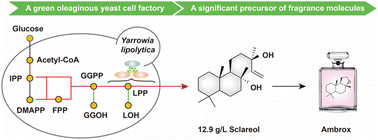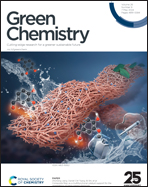Constructing a green oleaginous yeast cell factory for sustainable production of the plant-derived diterpenoid sclareol†
Abstract
Diterpenoids are an important class of secondary metabolites in nature with diverse applications such as pharmaceuticals, flavors and fragrances. Sclareol, a plant-derived diterpene alcohol from Salvia sclarea, is most commonly used as the starting material for the production of hemisynthetic Ambrox, a valuable substitute for ambergris from sperm whales used in perfumery. Here, we engineered the oleaginous yeast Yarrowia lipolytica as a chassis for sclareol overproduction. We constructed a de novo sclareol biosynthetic pathway by screening and engineering heterologous LPP synthase (Lpps) and sclareol synthase (Scs). By constructing a two-layer geranylgeranyl diphosphate (GGPP) accumulation pathway and scaffold-free multienzyme complexes, the metabolic flux was redirected toward sclareol synthesis, enabling significantly improved production of sclareol and reduced levels of by-products. The engineered strain was capable of producing 12.9 g L−1 of sclareol in a 5 L bioreactor, with this being the highest titer achieved to date. To the best of our knowledge, this is the first report of sclareol biosynthesis in Y. lipolytica, and this chassis strain may offer a groundbreaking foundation for the sustainable, large-scale fermentation of diterpenoids.

- This article is part of the themed collection: Green Chemistry Emerging Investigators Series


 Please wait while we load your content...
Please wait while we load your content...